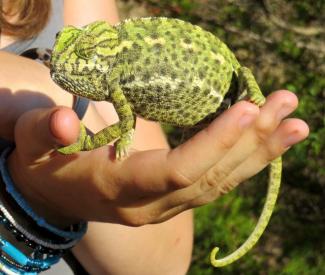
Tarifa is the southernmost point of continental Europe, and is the narrowest point of the Strait of Gibraltar, only 14 km away from the African continent.
Authors: Max Wolff, Pierre Gallego
This is the location where the Atlantic Ocean and the Mediterranean Sea connect, with warmer superficial waters from the Atlantic Ocean flowing eastwards, and deep, cold Mediterranean waters flowing westwards. The bathymetry of the Strait of Gibraltar is very irregular, with a mean depth of 500m and reaching a maximum of 1000m. This accidental bathymetry creates irregularities in the water masses, and in some areas cold deep water is directed towards the surface, creating socalled upwellings which are the source of high primary productivity.
These plankton blooms attract important schools of fish, which in turn attract important numbers of cetaceans. This is the reason why the Strait of Gibraltar represents such an important cetacean hotspot. It is probably the best place in continental Europe to study and observe dolphins and whales, and also a very interesting place for underwater invertebrates and fish.
Students participate in an ongoing research project
This research internship has been developed to offer undergraduate students a unique opportunity to participate in an ongoing research project including field research and data processing/interpretation. The participants dived around the Island of Tarifa, which is considered as a hotspot of biodiversity on the Spanish
coast. Standardized techniques were used to estimate abundance and distribution of marine invertebrates. These techniques included photographing and filming biotopes, as well as counting with a set 1 square meter frame.
Killer whales, dolphins and fishermen
The date of the internship coincided with the seasonal presence of killer whales in the Strait of Gibraltar, where these dolphins come to hunt bluefin tuna. This
leads to interactions with the local fishermen who also target this large and expensive fish. The killer whales have learnt to steal the tuna from the fishermen’s lines, and we monitored this interaction closely. The students were confronted with the fisheries issues and competition problems between man and cetaceans. We observed 5 species of dolphins and 3 species of whales.
Various research techniques
The participants were initiated to different research techniques which are not specific to marine species, and are entirely transferable to other species, e.g. terrestrial mammals and birds. The main source of information in our research relied on recording data on environmental factors such as wind and sea state for
every sighting. GPS position, behavior and reaction of the cetaceans towards the whale-watching vessels are some of the many other variables recorded.
For each sighting, photographs were taken of the dorsal fin and/or caudal fin (depending on the species) in order to identify individual animals. We visited the Center for Cetacean and Sea Turtle Rescue (CREMA) of Algeciras, and took part in a turtle necropsy. We also found wild reptiles, of which chameleons, with the help of our experienced wildlife guide Francisco Gimenez Casares.
Tarifa
The youth hostel where we were staying had been completely refurbished, with in-room bathroom, swimming-pool, free wireless internet, and is located half-way between Algeciras and Tarifa, only a 15 minutes drive from the Tarifa harbor.
The Strait of Gibraltar is an interesting place in many respects: geologically (the Eurasian and the African tectonic plates meet there), historically (there are
ancient Phoenician and roman ruins, as well as cave paintings, some dating as far back as 12000 years), biologically (interesting underwater life, one of the main bird migration routes in Europe), culturally (it was the place of intense exchange between Europe and Africa), culinary (the Spanish and Moroccan cuisine are varied and delicious) and recreationally (Tarifa’s beaches offer many free-time opportunities).
Infobox
The research internship “Marine Biology Internship Tarifa 2012” was organized
by Max Wolff, Biology professor at the European School of Luxembourg, and Dr
Pierre Gallego, a veterinarian specialized in marine mammals and who has
carried out research in the Strait of Gibraltar for the past 9 years.
The internship took place during the summer of 2012 (10-19 July) in the little town of Tarifa in
the Strait of Gibraltar, Cadiz, Spain. 7 students from different schools (EE LuxI,
LMRL, LCD) participated.
